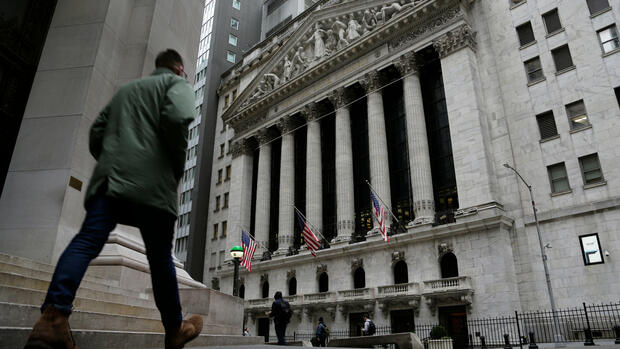new York The major US banks are prepared for a serious economic crisis, as the results of the bank stress tests show. The financial system is “strong and resilient,” said Michael Barr, Vice Chairman of the US Federal Reserve (Fed), who is responsible for regulation.
In the negative scenario of the US Federal Reserve (Fed), which assumed a severe economic downturn, the 23 tested institutes were able to maintain an average capital ratio of 10.1 percent, as the Fed announced on Wednesday after the US stock market closed. The institutes are thus well above the minimum rate of 4.5 percent and could continue to provide companies and households with loans in an emergency.
The Fed assumed that in a hypothetical crisis, banks would lose a total of $541 billion, including $100 billion in commercial and residential mortgage losses. Unemployment jumped to ten percent in the scenario.
In terms of expected loan defaults, Deutsche Bank and Charles Schwab were among the top performers. On the other hand, America’s largest bank JP Morgan Chase and Wells Fargo would have to reckon with the biggest losses. However, the core Tier 1 capital ratio would fall the most at Deutsche Bank’s US subsidiary. According to industry experts, this is due to the fact that the Frankfurt institute has no private customer business in the USA.
The Fed’s models were changed this year, which also influenced the calculation. The hard equity ratio of the US subsidiaries of UBS and Credit Suisse would also fall comparatively sharply in the crisis scenario.
Alternatives to the stress test
The Fed’s stress tests used to be feared. Institutions that failed the tests had to put share buyback plans and dividends on hold until regulators deemed their capital reserves strong enough again. If the Fed found weaknesses in compliance, i.e. trading in accordance with applicable law, they had to be corrected quickly. That was the case at Deutsche Bank in the past.
Now, however, the stress tests have been softened. Banks can no longer fail and smaller institutes are only tested every two years. The parameters of this year’s test are also subject to criticism. The banks had to show that they still had sufficient capital even in a severe crisis.
However, the question of what happens if interest rates rise at a record pace was not part of the official test. The consequences of rising interest rates were only sounded out in a so-called “exploratory test”. However, this was not included in the bottom line, as the Fed announced.
More on the subject:
Vice President Barr also acknowledged, “This stress test is just one way of measuring the strength of banks.” Regulators should “remain humble” and ensure institutions are “resilient to a range of economic scenarios, market shocks and other stresses.” .”
After the bankruptcy of the Silicon Valley Bank (SVB) and the crisis at US regional banks in March, the Fed has been criticized twice. The central bankers announced a turnaround in interest rates last March and have since raised the key interest rate at record speed to between 5.0 and 5.25 percent.
However, the consequences of this interest rate hike were not taken into account in their stress tests. At the same time, the Fed, which is also a key banking regulator, has had to acknowledge mistakes. According to a report by the central bank in May, various shortcomings at the SVB were known to exist, but they had not acted decisively enough.
Reforms are pending
Now that the situation at the regional banks has stabilized again, regulators are discussing a number of regulatory reforms to prevent further bank failures. Currently, the Fed and the FDIC, also a key banking regulator, are exploring a number of ideas. Barr brought up a kind of “reverse stress test” last week.
The current stress tests measure how institutions fare in certain crisis scenarios. But the method has weaknesses, as the bank failures in March made clear. Instead, regulators should ask themselves, “What are the chances of a particular institution not surviving?” Barr said at a conference. The approach is comparable to so-called “white hat hacking”, in which companies deliberately hire hackers to find weak points in their systems.
In a congressional hearing last week, Fed Chairman Powell suggested that the capital requirements of the eight largest US banks could be increased by around 20 percent. And FDIC boss Gruenberg is considering demanding larger capital cushions from smaller banks with total assets of $100 billion or more. Like larger institutions, they could therefore also be subject to the international standards known under the keyword Basel III.
The associated uncertainty is also the reason why many banks are holding back this year when it comes to share buybacks and dividends. For example, Basel III requirements are pending, which will redesign the capital regulations for banks. The Fed has also announced that it plans to make changes to banking supervision following the collapse of four regional banks earlier this year.
Starting Friday, banks can announce their buyback or dividend plans. Bank managers have already practiced expectation management in the past few weeks, which applies to both large and small institutions. For example, America’s largest bank, JP Morgan Chase, assumes that its capital requirements will increase.
The same applies to US Bancorp and Huntington Bancshares. Both institutes announced that they would take a very defensive approach to their capital management in order to be prepared for stricter requirements. Barclays analysts expect the largest US banks to pay out a good eight percent less to shareholders than last year.
Bank stocks reacted largely positively to the stress test results in after-hours trading. JP Morgan’s paper rose a good 1.7 percent. Goldman Sachs stock rose 1.2 percent.
More: ECB prepares banks for tougher stress test results
